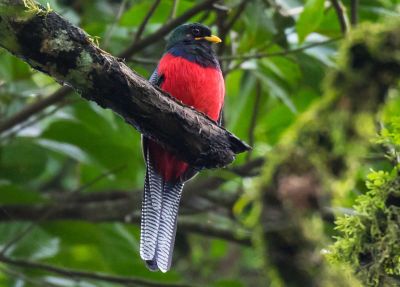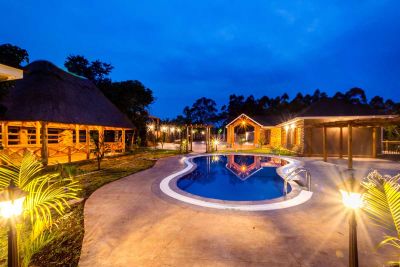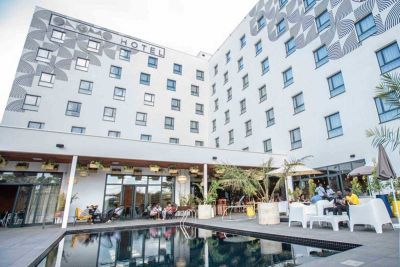14 Days Birding Trip
14 Days
Overview
Be prepared for warm to hot, dry and sunny weather on most days. Overcast conditions will occur, Uganda being surrounded by tropical rain forests and fresh water bodies it can rain any time of the day and year. It will be warm to cool at higher elevations. It is recommended to take a light rain-jacket, although we will try to avoid birding in any rain worse than a light drizzle, and good, sturdy, waterproof footwear. Walking conditions will be relatively easy but trails anywhere may be muddy depending on how recently it has rained.
Throughout this birding tour, we will travel in a 4 WD land cruiser or safari Omnibus with an open roof hatch to maximize wildlife viewing opportunities. Bring insect repellent and/or mosquito-proof clothing because bugs can be a menace, again depending on the rain. It will be necessary to bring a hat and sunblock. In the evenings we usually eat at the hotel or lodge where we are staying, and review the list of birds and other wildlife that we have encountered, as well as discuss the following day’s activities.
Much as this birding tour can be done throughout the year, at Birding Journeys Uganda, given our experience, the senior guides recommend June, July or August, but December, January and February are good months as well for this trip.
What’s Included
-
English-speaking guide
-
Park fees
-
Boat cruise
-
Park Ranger
-
Hiking
-
Bottled water
-
Transport in 4X4 vehicle
-
Meals
-
Safari accommodation
-
airport pickup & Dropoff
-
International flights
-
Visas
-
Kampala accommodation
-
expensive drinks
-
cigarettes
-
laundry
-
crafts
-
souvenirs
-
tips
Itinerary




Bwindi is the Bird watchers haven! It holds 348 species of birds among which 90% of the Albertine rift Endemic are here i.e the Short-tailed, Rusty-faced woodland and Grauer’s Rush Warblers, Bar-tailed Trogon, Wilcock’s Honey-guide, Yellow-eyed black Fly-catcher, Kivu Ground Thrush, Dusky Crimsonwing, White-tailed Blue Monarch among others, difficult or impossible to see in any other part of East Africa.
An experienced bird watcher can identify up to 100 species in a day. Diner and overnight at buhoma lodge , Bakiga lodge , rushaga gorilla lodge and other options.

After breakfast, we will drive to QENP with several birding hotspots and arrive in time for lunch at the optional lodge youll like from Mweya safari lodge ,Kingfisher Safari resort, Enganzi lodge or other budget options .
Later we will embark on our birding expedition around the park and return for dinner and o/n at our respective hotel. Rooms are all in suite.

Whole day birding in the Park looking out for the Grey-headed Kingfisher, Swamp Flycatcher, Black-headed Gonolek, Grey-capped Warbler, Slender-billed, yellow backed, Black Headed, Lesser Masked and Golden Backed Weavers, Yellow Fronted and Brimstone Canary. We take an early morning game drive towards the famous Kasenyi Track, winding through grassland dotted with trees and nearby crater lakes.
Our main aim is to locate Lions and other mammals including Buffalo, Ugandan Kob (an antelope that resembles impalas), Oribi, Waterbuck, Bushbuck and family groups of African Elephants. Along the road we may find Scaly Francolin, Red-necked Spurfowl, several plovers, Harlequin Quail and Common Button-quail. Larks are numerous and include, Red Capped, Rufous-napped, Flappet and the local White-tailed.
Raptors include Martial Eagle, Banded Snake Eagles and Bateleur. In the afternoon we embark on a boat trip down the Kazinga Channel. This incredible area for waterbirds will afford stunning views of African Skimmer, Pink-backed Pelican, Saddle-billed, African Open Billed and Yellow Billed Stork, Hamerkop, African Spoonbill, Water Thick-knee, and over-summering Palearctic migrants. In the evening before dinner we will try a night drive with in the peninsular searching for Gabon and Slender-tailed Nightjars, as well as owls if staying on the peninsular.

After breakfast this morning, we will drive to Kibale National Park birding on the way. This is a few hours drive and therefore birding along the way or afternoon birding in the forest is rewarding.
Check in at the Primate Lodge, Chimpundu lodge, Crater safari lodge or chimpanzee guest house

Today we will spend our full day at the Kibale NP with birding and Chimp tracking. After breakfast, we enter the forest and do birding. The forest is home to the Scaly Francolin, Marsh Tchagra, Black-bellied Seedcracker, Green-backed Twinspot, Bicoloured Mannikin, White-naped, Green and Afep Pigeon, Narina’s Trogon, Joyful Greenbul, Olive Long-tailed Cuckoo, Black Bee-eater, Blue-headed Coucal, Blue-breasted Kingfisher, Scaly-throated Honeyguide, Roufous Flycatcher Thrush and Black-faced Rufous Warbler, Brown and Scaly Breasted Illadopsis, on a lucky day the Green Breasted Pitta will be present.
After lunch we assemble at the chimp tracking briefing ground, where we will learn all the required procedures. It is not strenuous, but can sometimes take longer depending on our luck. Kibale Conservation Area has 13 species of primates which are both nocturnal and diurnal beating the world record as the highest concentration compared to any forest. These include Chimpanzee, Red Colobus Monkey, Grey-cheeked Mangabeys, Red-tailed Monkey, Chimps, Blue onkey, Olive Baboon, I’hoests Monkey, Black and White Collobus Monkey, Valvet Moneky and Galagos, Pottos, to mention but these.


Today, we will spend the whole day birding at Murchison Falls National Park. After breakfast we cross the river for a game and birding drive on the northern section of the mighty River Nile. If we stay at Sambiya there are very good chances of seeing the Nightjars among others the pennant winged, plain and Swamp not leaving out Owls and early cats like the Leopard, Lion Civets etc.
Lunch will be picnic after which we proceed for a boat cruise to the bottom of the falls. Key species of Murchison Falls include, Bat Hawk, Red-necked Falcon, African Black Scimitarbill, Spotted Morning thrush, Silverbird, Bronze-tailed, Lesser Blue Eared, Splendid and Ruppel’s Long Tailed Starling, Beautiful Sunbird, Northern Red Bishop, Rock, White-rumped Seedeater, Black-billed Barbet, Grey-headed Olive back, White-crested Turaco, Egyptian Plover, Bruce’s Pigeon, Pel’s Fish-owl, Carmine, Swallow Tailed, Little, Blue Cheeked and Red Throated Bee-eater, Brown-backed Woodpecker,White-fronted Black Chat, Cabanis’s and Brown-rumped Bunting, Black-rumped and Fawn Breasted Waxbill and Bar-breasted, Firefinch, Abyssinian, Broad Billed and Rufous-Crowned Roller, on the water the Four-banded Sandgrouse and Rock Pranticole are often sighted among others.


